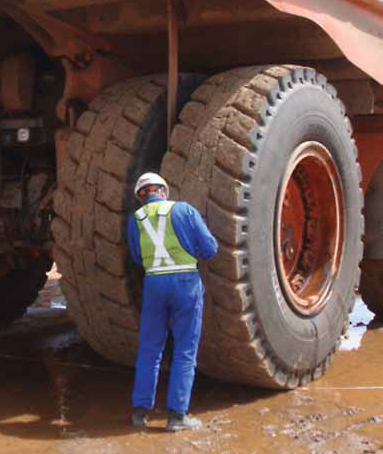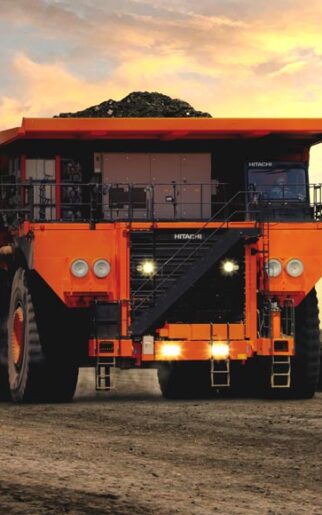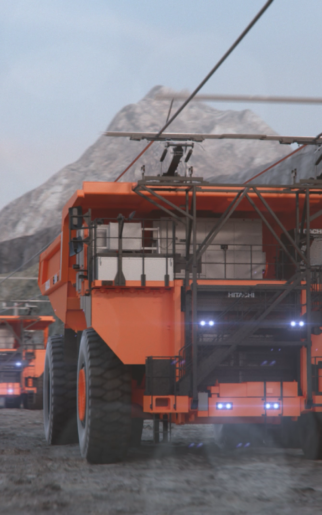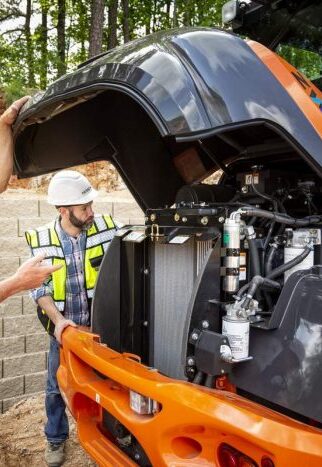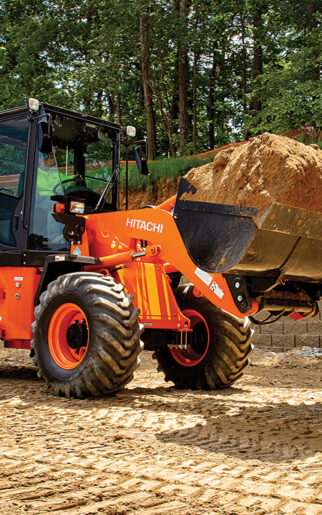Downtime can cost significant money. While there are some instances of downtime that are unavoidable, there are measures you can take with your equipment that can help avoid those associated costs.
Proper tire maintenance, even at its most basic level, will have a dramatic effect on avoiding downtime. Basic tire maintenance and monitoring is easy, and there is no time like the present to start following important maintenance tips to ensure that tires operate at peak levels throughout any season. The following 10 areas for immediate improvement regarding tire performance apply to mining but many are equally important in construction. While an in-depth tire management and maintenance program will reap significant benefits, just paying attention to these basic areas will help provide more productive, longerlasting tires and avoid costly downtime.
 #1 – Air pressure maintenance
#1 – Air pressure maintenance
Just as humans need air to live, tires depend on air to live too. They need the right amount of air pressure to function at their optimal performance. A radial earthmover tire that is either over- or under-inflated is vulnerable to potential downtime. If no other tip is remembered, this is the one to note and to take steps to implement as quickly as possible.
All tires should be kept at the pressure specified by the tire and vehicle manufacturers. The correct tire pressure for a radial tire will vary widely depending on the machine type, manufacturer model type and weight. It is always a good idea to consult the tire manufacturer to ensure that each axle is properly weighed and the correct pressure is set. The manufacturer can also answer questions and provide additional tire advice based on a site’s specific terrain and layout.
Any vehicle with properly inflated radial tires carries its load in a noticeably different way. Radial tire technology separates the work done by the sidewall and tread areas, allowing the tire to conform to the terrain by running at lower air pressures than bias tires. This lower air pressure yields a more even footprint and higher levels of traction for radial tires. The constant footprint ensures that the lugs strike the contact patch simultaneously, reducing vehicle vibration. However, if the tire is over-inflated, many of these radial advantages and increased productivity benefits are lost.
As for the frequency of checking tire pressure, this should be done on a daily basis or at least weekly. Regular pressure checks will reduce the risk of running the tires without the proper air pressure, which can lead to decreased tire life. Tire pressures should be measured and managed by trained maintenance staff.
“The utilization of an automated system that monitors tire pressure in real time (such as Michelin’s MEMS technology) can help assure that regular and consistent monitoring is being maintained.
Pressure check results should always be recorded for later comparative analysis. This is the only way to determine if, and which tires are slowly leaking air. Once a leaking tire is identified, it can then be examined and the problem addressed.
Michelin recommends using new Orings and checking all wheel components when mounting a new tire to ensure a proper seal and reduce the risk of pressure loss. It is also important to review and inspect the condition of wheels on a regular basis to detect any damage that may have occurred during operation that could lead to a loss in pressure.
#2 – Driver awareness
Because the operators are on-site all the time, they see problems that need to be fixed, whether it’s in their pre-trip inspection or while operating the equipment. Managers and supervisors can draw their operators into the equation by asking for input and cultivating a team approach to tire and vehicle maintenance. Operators should be kept in-the-loop on situations with their equipment or tires, so they are aware when they conduct inspections or operate the equipment.
It is crucial that operators report any spillage, whether from their vehicles or other vehicles. Increasing the operator’s awareness about their part in taking care of equipment and tires and avoiding hazards around the site, will increase team mentality and help avoid downtime.
#3 – Tire and rim inspection
All vehicle operators should do a thorough walk-around inspection of their vehicle before beginning operation. They should look for cuts, holes, cracks or any other damage to tires or wheels. The constant inspection of a rim and tire helps to minimize and detect any issues in a timely manner and ensure they are dealt with before becoming major maintenance issues, or going beyond the point of serviceability.
During tire and wheel checks, Michelin also recommends examining all rim hardware for any signs of cracks or flange damage. It is also important to check the valve hardware for signs of damage or wear.
#4 – Haul road maintenance
Maintaining a mine site’s haul roads can help prevent tire punctures and other damages. When designed and maintained properly, haul roads can reduce negative impacts on tire life. Site planners and haul road maintenance personnel should pay special attention to road surface conditions, super elevations, curve radii and speed in curves.
Haul road design should be considered in concert with the tread compound of the tires being used. Certain compounds are better suited to short hauls as opposed to longer hauls. If used in the wrong application, tires can be damaged beyond serviceability.
Hauling on steep grades will cause the load to shift toward the front or rear of the vehicle. If hauling downhill while laden, pay special attention to the pressures of the front tires and set them according to the operating conditions. This compensation should be done only after consulting with the tire manufacturer representative to ensure proper tire pressure settings. It is best to avoid grades higher than 8 percent to reduce these load transfer effects. When designing haul roads, it is also important to use the appropriate curve radii in turns, so they are not too tight. Build a crown into the roads at approximately 3 percent to help with water run-off. Standing water or puddles on the haul roads can hide rocks and other debris that could damage the tires.
#5 – Mechanical vehicle maintenance
When it comes to tire life optimization and avoiding downtime, maintaining the vehicle is critically important. Brakes, struts, rock knockers and alignment all need attention to function properly and not have an adverse effect on a vehicle’s tires. Ensuring the vehicle is correctly aligned helps to prevent uneven wear on the steer axle tires. It is also important to check the suspension regularly through a comprehensive strut maintenance program and to evaluate the rock ejectors for any potential problems.
#6 – Load management
Load management is another crucial area for trucks because of the significant weights carried by just six tires. When a load is not centred, it can often put too much weight on one corner of the truck, causing an overload on that corner’s tires. Overloading tires will lead to shorter tire life or downtime. Even if properly centered, every load should stay within total gross vehicle weight (GVW) compliance. Michelin also suggests conducting weight studies regularly.
#7 – Support equipment
The role of support equipment on a site should not be minimized or overlooked. At a mine, they play a vital role in keeping haul roads clear of rocks or other debris that could damage tires. A motor grader or rubber-tired dozer should be used on a regular basis, not just for the haul roads, but also for the loading and unloading areas to cleanup any spillage. As mentioned previously, operator training should include communicating and reporting work area spillage.
#8 – Scrap tire analysis
Tires will normally display what happened to them to cause them to come out of service. Inspecting scrap tires as they come out of service can help prevent future tire loss and indicate the need for tire or vehicle repairs or adjustments in vehicle operation.
It is an important step to analyze the history of scrap tires and evaluate and determine the type of tire damage, the vehicles on which the tires were operating, as well as the area of the site. Also key to the evaluation are load distribution and weight transfers or misalignment. These areas, discussed previously, can lead to tires prematurely coming out of service. If the problem is accurately diagnosed, changes and new practices can be implemented to correct the issue.
#9 – Tire performance improvement committee
Establishing a tire performance improvement committee can benefit a mine site by forcing discussion on how tire assets are being used and maintained. The committee should be composed of personnel from different areas of responsibility at the site. Maintenance, operations, production and operators should each have a voice and provide their input to improve and enrich the meeting and the site’s tire policies.
Michelin recommends regular monthly meetings of the committee to discuss any needed and relevant changes concerning tires and to assign tasks for correcting any issues that come up. It is also critical to allot the necessary time during meetings for each topic, so that each issue is afforded the attention it deserves.
#10 – Communicating/reporting
The last area that can help improve tire performance and avoid downtime is to generate clear and specific policies and reports of all the initiatives and progress made in any meetings. For tire maintenance to succeed, policies must be written, communicated, monitored and enforced.
Policies or reports should be shared with all applicable staff so that they can be aware of the areas of improvement or change, as well as be able to provide input for future changes or additions to tire or other maintenance policies.
Proper understanding of tire basics and maintenance will impact an entire site by keeping vehicles operating at maximum efficiency. By following these 10 simple steps, any operation can take full advantage of its tire investment, boost productivity levels and avoid that costly condition – downtime.

